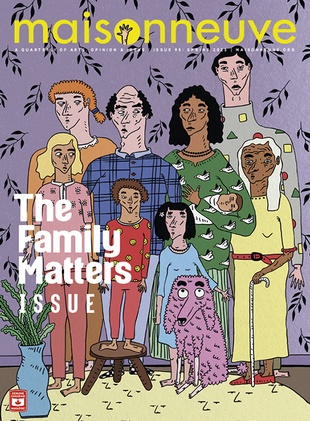The Family Recipe
Variations on a theme are the only constant in this Italian kitchen.
My mushroom-barley soup is legendary. “It’s no big deal,” I’ve been telling friends for years, “just follow the Moosewood.” By which I mean, of course, The Moosewood Cookbook, Mollie Katzen’s vegetarian classic. Recently, however, a frustrated friend who tried to make the musky, robust dish with less-than-stellar results asked that we prepare it together. Only then did I realize that I had strayed far from Katzen’s instructions with the potent addition of wild and brown rice and rehydrated porcini and morels.
My soup, in other words, wasn’t a note-perfect cookbook creation. But isn’t that the way it often is with recipes? Food writer M.F.K. Fisher insists on the recipe as “a formula, a means prescribed for producing a desiredresult.” But beyond the basic how-to of method and ingredient, recipes also require personal interpretation, like a piece of music or a play. And the near-infinite decisions that are possible mean that outcomes can vary widely.
Don’t get me wrong: I’m no DIY cook. Sitting on a handcrafted bookshelf in my Montreal apartment you’ll find a 1938 first edition brown leather Larousse next to the newest Joy and many books by Fisher. You’ll also find thousands of recipes by Escoffier, Brillat-Savarin, Julia Child, Elizabeth David, Marcella Hazan, Madhur Jaffrey and Donna Hay; clinical prescriptions for butchering, weight, measurement and cooking time charts and food safety courtesy of The New Professional Chef; miscellanea in The Food Chronology and Everything You Pretend to Know About Food and Are Afraid Someone Will Ask; British humour in Two Fat Ladies Ride Again and irreverence in The Mafia Cookbook (plus a damn good veal Marsala recipe); and some rock ‘n’ roll from Anthony Bourdain.
The food prepared from these books has provided me with escapism, pleasure, sustenance, friendship, therapy, wisdom and redemption. Yet I’ve rarely followed their recipes down to the last detail. In this way, I’m staying true to tradition. For the women in my family, recipes have always existed somewhere between prescriptive state and unwritten outcome. All that matters to them—after the dish has been consumed, that is—is the memory of making and eating it. Moreover, these women not only live their relationships through food, but act out their relationship to food. And like any performance, the theatre of it can matter as much as the text.
Take my mother. Among her specialties is a meatball that leaves you in a gustatory stupor. You bite through a subtly charred exterior into a layered softness of minced bits, seasoned breadcrumbs, Parmesan, as well as garlic and parsley. Or was that basil? Or both?
Every few weeks she makes huge batches in three different sizes: polpettine (bite-sized for soups or as fritters sprinkled with coarse sea salt) and medium and large for tomato sauces. She browns them on very high heat for a few seconds, parboils them and divvies them up into freezer bags which are then dispensed to my brother and me, as well as select family members and friends. Every few weeks, with varying degrees of failure, I’ve tried to get her secret:
—How many eggs for how much meat did you use?
—Your godfather got the eggs at that farm up north. He brought me a chicken too, the size of a turkey! We’ll make a nice broth.
—But what kind of meat is in the mixture here?
—I don’t overwhelm it with too much pork, like your aunt Teresa, no, no, you need the right balance with the veal, otherwise they’ll come out dry and ordinary.
—Yes, and how much of each exactly?
—But with so many kids, it’s always been like a feeding trough at your aunt’s.
Mamma is incapable of providing straight answers. All I know for certain is she uses pork and veal, possibly some beef—or is it lamb? I think she uses three different lean-to-fat grades of meat minced quite finely, but I’m not sure. That information is between her and her butcher.
My grandmother is an even tougher nut to crack. But to tell her story right, I need to give you the setting. It’s 1994 and I’m visiting my grandparents in Agrigento in southern Sicily. Their son, Carmelo, is coming down with his wife, Afra, from Trento near the Italian Alps and Austrian border. A native Trentina, Afra hardly ever accompanied my uncle, a doctor (and the only professional in the family) to Sicily. I myself had met Afra only once. Her Italian was the sort I’d learned in Florence, Dante’s Italian, rather than the Sicilian dialect spoken by my family.
A week earlier Nonna had come into Carmelo’s old room, where I was staying. She pointed to Il Cucchiaio d’argento.
“Your aunt Afra gave it to me for Christmas.”
She fastened her thin arms under her bosom and the floral housecoat lifted above the knee-high nylons.
“Apparently it’s a very important book.”
She tightened her arms, lifting the housecoat further above the knees.
“EVERYONE should have this book.”
Il Cucchiaio d’argento is an exhaustive compendium of traditional Italian recipes, prescriptions for hundreds of antipasti, frittatas, pizzas, salads and greens, crustaceans and shellfish, game, cheese, dolci. My grandmother, however, is semi-literate and has never used a cookbook in her life. Il Cucchiaio d’argentoalso has pages of polenta recipes, a rarity in Sicilian cookery. This last detail is especially ironic given that Italian southerners, derided as terroni (peasants), retaliate by referring to northerners as polentoni—“bland like polenta.”
“We’ll make a cake from The Book. It’ll make your uncle happy.”
She tossed The Book onto the bed. “Go ahead, pick a nice cake for your uncle—and the Austrian, of course.”
The day for The Cake was at hand. My uncle and his wife were on their way in from Palermo airport across the island. The miscatedri and pizzettewere in the wood-burning oven next to the chicken coop. Smoke from the charred wheat stems and vine twigs wafted into the kitchen.
“Franca, which one is it again?” my grandmother asked, flipping through Il Cucchiaio d’argento.
“This one, Nonna, torta di nocciole.”
My aunt Carmela came in with fresh eggs. Nonna pointed to the recipe for hazelnut cake.
“Instead of butter we’ll use oil.”
Nonna went down the list of ingredients.
“We have no self-raising flour here so this will have to do.”
She pointed to the mound of flour on crumpled paper that had been used for the miscatedri. Zia Carmela expertly separated six eggs—the recipe called for two, whole.
“A few more eggs won’t hurt,” said my aunt.
She beat the yolks with sugar and vanilla. In perfect synchronicity with her daughter, Nonna whisked the whites. She folded them into the fluffy yolk mixture, sifted in flour and folded everything together.
Ignoring most of the ingredients and instructions for torta di nocciole, Nonna had made her usual sponge cake! By the time Carmelo and Afra had settled in, the cake had cooled. Nonna cut it while Carmela poured iced espresso. The cake was served with hazelnut gelato and very finely chopped nuts sprinkled on top of both.
“Si, si buonissima,” said Afra, her blond hair in a chignon set off by pearls and a navy blue knit suit.
Nonna patted Il Cucchiaio d’argento which sat on the table. “Franca chose the recipe.”
Carmelo beamed and asked for seconds.
When I think about the dance my mother and I play when we cook together, or of my grandmother’s “recipe” for torta di nocciole, I can’t help but wonder what my own mushroom-barley soup says about me? Hopefully that I’m robust and lush! My mother would want to add pork sausage, a hint of thyme (or would that be sage?) and definitely a few of her polpettine. And my grandmother would roll her eyes at the porcini and morels—wild mushrooms, and vegetarians, are a thing of the north—and simply replicate her mainstay dish: veal in tomato sauce stew. I think M.F.K. Fisher would love it.





